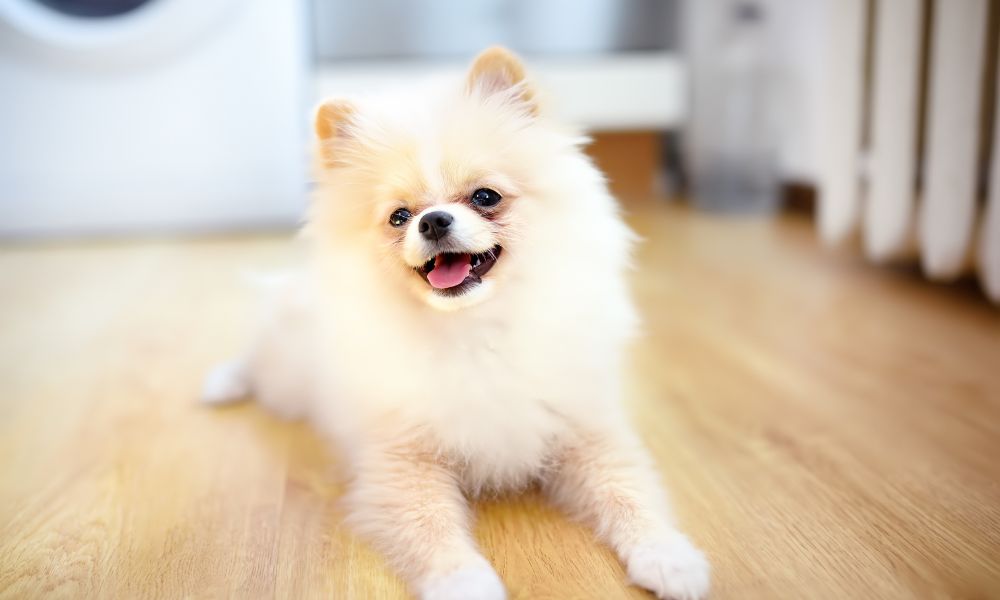 7 Nov
7 NovCan Pomeranian Be Left Alone?
If you’re the proud parent of a Pomeranian, you know that these little balls of fluff are more than just pets—they’re family. Brimming with personality and energy, Pomeranians are renowned for their loyal and affectionate nature. This might lead you to wonder, can these companion-focused pups handle the solitude when life demands you step out without them?
Yes, Pomeranians can be left alone, but they thrive best with companionship. These petite dogs do have a capacity for independence, but the duration should be limited. Adult Pomeranians can be left alone for about 4 to 6 hours, provided they have been trained, have a safe space, and are given plenty of exercises before they leave. For Pomeranian puppies, the time alone should be shorter due to their more frequent potty breaks and need for socialization.
In the upcoming sections, we’re going to explore the unique temperament of Pomeranians, their capacity for independence, and practical steps to ensure they remain happy and healthy even when they’re home alone.
Whether you’re a seasoned Pomeranian owner or considering welcoming one into your home, understanding the ins and outs of what makes your Pom comfortable with alone time is crucial. So, let’s get started on ensuring your furry friend’s well-being, even in your absence.

How Long Can Pomeranians Be Left Alone?
Pomeranian Puppies vs. Adults
The question of how long Pomeranians can be left alone does not have a one-size-fits-all answer, as it varies significantly between puppies and adult dogs.
Pomeranian puppies, with their boundless energy and developing bladders, should not be left alone for more than 1-2 hours at a time. They require more frequent potty breaks, meals, and social interactions to help them develop into well-adjusted adults.
On the other hand, adult Pomeranians can manage a bit more solitude. Typically, a healthy adult Pom can be comfortable alone for around 4-6 hours, given that their physical and emotional needs are met. This includes having had enough exercise, mental stimulation, and a comforting environment that feels safe.
Assessing Your Pomeranian’s Tolerance
Every Pomeranian has a unique personality, and their tolerance for being alone can vary. Some may handle solitude well, while others might get anxious or stressed. Observing your Pom’s behavior is key to understanding their limits. Signs of distress, such as destructive chewing, excessive barking, or accidents, can indicate that your Pomeranian is not coping well with being left alone. Gradually increasing alone time and providing positive reinforcement can help build their tolerance.
Expert Opinions on Alone Time for Small Breeds
Experts generally agree that while small-breed dogs like Pomeranians can adapt to being alone for certain periods, they still require plenty of interaction and engagement. Small breeds are often more prone to separation anxiety and benefit from a consistent routine.
To support a Pomeranian’s well-being, experts recommend interactive toys to keep them engaged, regular training sessions to promote independence, and, if possible, a midday check-in from a pet sitter or dog walker to break up their time alone.
Preparing Your Pomeranian for Alone Time
Ensuring your Pomeranian is comfortable with being alone is an essential part of their care. Here are strategies to help your furry friend feel more relaxed when you’re not home.
Training Tips to Reduce Separation Anxiety
Training your Pomeranian to cope with alone time should start early and progress gradually. Begin by leaving your Pom alone for just a few minutes each day and slowly extend the duration. This helps them understand that you will always return. Here are some tips:
- Crate Training: Teach your Pom to associate their crate with safety and comfort. This can be their personal space where they feel secure when you’re gone.
- Desensitization: Gradually get your Pom used to your departure cues, like picking up keys or putting on a coat, without actually leaving, to reduce anxiety associated with those actions.
- Farewell Cues: Avoid emotional departures. A calm goodbye routine can set a peaceful tone.
- Positive Reinforcement: Offer treats or praise when your Pom remains calm as you leave, reinforcing that alone time can be a positive experience.
Creating a Safe and Comforting Environment
Your Pomeranian’s environment should be a haven where they feel safe and relaxed. Ensure this by:
- Safe Space: Set up a comfortable area with their bed, crate, or blanket that smells like you.
- Controlled Environment: Keep the temperature comfortable and consider background noise like a TV or radio to mimic the presence of people.
- Access to Water and Toys: Make sure they have fresh water and a selection of toys to keep them occupied.
The Role of Mental Stimulation and Physical Exercise
A well-exercised Pomeranian with plenty of mental stimulation will likely rest while you’re away. Incorporate these elements into their routine:
- Exercise Before Leaving: A good walk or play session before you leave can tire them out, so they spend part of the time you’re away resting.
- Mental Games: Use puzzle feeders or toys that encourage your Pom to think and work for their treats.
- Rotating Toys: Keep their interest by rotating different toys that will be available to them when you’re gone.

The Impact of Prolonged Solitude on Pomeranians
Spending too much time alone can have adverse effects on your Pomeranian’s well-being. Understanding these impacts can help you take proactive steps to ensure your pet stays healthy and happy.
Behavioral Issues Resulting from Excessive Solitude
Pomeranians are sociable creatures by nature, and excessive solitude can lead to a number of behavioral issues, including:
- Destructive Behavior: Chewing on furniture, shoes, or other household items can be a sign of boredom or anxiety.
- Excessive Barking or Howling: This can be a call for attention or a display of frustration with their isolation.
- House Training Setbacks: Even well-trained Pomeranians might have accidents if left alone for too long without access to a bathroom area.
Signs of Distress in Your Pomeranian
To gauge whether your Pomeranian is struggling with the time spent alone, look for signs of distress:
- Changes in Appetite: Lack of interest in food can be a stress response.
- Overgrooming: Licking or chewing their fur excessively can be a soothing action when anxious.
- Pacing or Restlessness: Difficulty settling down can indicate anxiety.
- Withdrawal: A noticeable lack of excitement or energy when you are around could be a sign of depression.
Long-term Effects on Health and Behavior
Prolonged periods of solitude can lead to long-term issues for your Pomeranian, such as:
- Chronic Stress: This can suppress the immune system, making your Pom more susceptible to illnesses.
- Separation Anxiety Disorder: This condition can lead to a persistent state of fear when alone, which is difficult to treat without intervention.
- Social Withdrawal: If a Pomeranian is not socialized due to extended periods of isolation, they may become fearful or aggressive around people or other dogs.
Solutions for Your Pomeranian’s Alone Time
If you find that your Pomeranian needs to spend some time alone, there are several solutions to ensure that they remain happy and stimulated in your absence.
Hiring a Pet Sitter or Dog Walker
One of the best ways to reduce the impact of solitude on your Pomeranian is to hire a pet sitter or dog walker. This solution can offer:
- Companionship: A sitter can provide much-needed interaction and emotional support.
- Exercise: A dog walker will ensure your Pom gets the physical activity they need to stay healthy and calm.
- Peace of Mind: Knowing someone is checking on your Pom can relieve your stress about leaving them alone.
- When selecting a sitter or walker, look for individuals with good references and the right temperament to handle the vivacious spirit of a Pomeranian.
Doggy Daycare: Pros and Cons for Pomeranians
Doggy daycare is another popular option, with both benefits and considerations:
- Socialization: Daycare can provide a great opportunity for your Pomeranian to meet and play with other dogs, which is excellent for their social development.
- Structured Routine: Many daycares have a set schedule of activities, which can be comforting to dogs.
- Cost and Environment: It can be expensive and may not suit every Pomeranian, particularly if they are shy or do not thrive in a pack environment.
Assess your dog’s personality and your budget to decide if daycare is the right choice for your Pom.
Interactive Toys and Activities for Solitary Pomeranians
Interactive toys and activities can be a lifesaver for an alone Pomeranian:
- Puzzle Toys: These stimulate your Pom’s brain, keeping them busy and engaged.
- Treat-Dispensing Toys: Toys that release treats can provide hours of entertainment and a tasty reward.
- Chew Toys: Durable chew toys can help relieve the boredom and stress that may come with being alone.
Remember to rotate the toys to keep things fresh and interesting for your Pomeranian. Additionally, leaving a piece of clothing with your scent on it can be a comforting reminder of you while they play.




